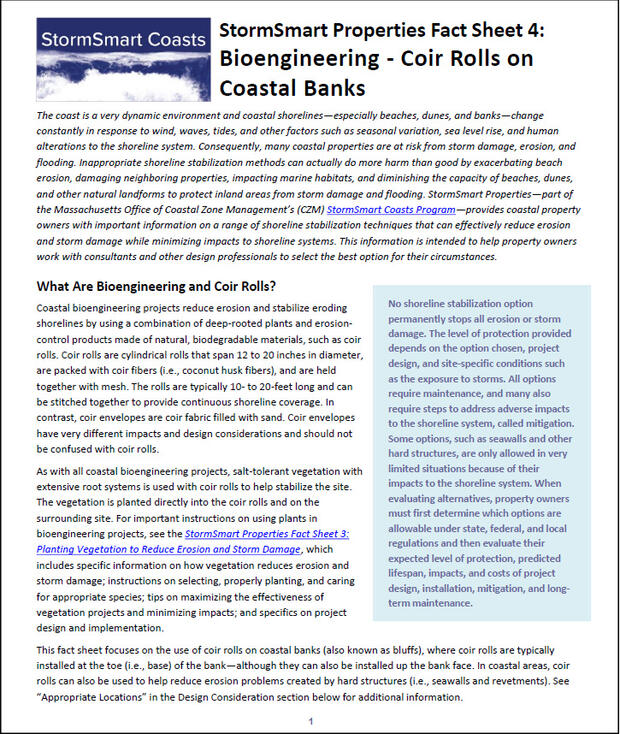CZM's StormSmart Properties fact sheets—developed as part of the StormSmart Coasts Program—give coastal property owners options to effectively reduce erosion and storm damage while minimizing impacts to the shoreline and neighboring properties.
Fact Sheet 4 focuses on the use of coir rolls on coastal banks. Coastal bioengineering projects use a combination of deep-rooted plants and erosion-control products made of natural, biodegradable materials, such as coir rolls. Coir rolls are long, cylindrical rolls of mesh packed with coir fibers (i.e., coconut husk fibers). They can be stitched together to provide a continuous physical barrier that helps reduce erosion of exposed sediments on a bank. Coir rolls can be used on both sheltered and some exposed sites where there is dry beach at high tide, but may require more frequent maintenance in exposed conditions.
- PDF Version of Fact Sheet 4 (PDF, 7.2 MB)
- Cost Comparison Chart (PDF, 99 KB) - Compares relative costs of shoreline stabilization options.
Other Available StormSmart Properties Fact Sheets
- Fact Sheet 1: Artificial Dunes and Dune Nourishment- Sand, cobble, or other sediment (of appropriate size) is brought in from offsite to build a new dune (i.e., mound of sediment) or add to an existing dune to protect inland areas from erosion and flooding. Dune projects are appropriate for almost any area with sufficient space to maintain some dry beach at high tide.
- Fact Sheet 2: Controlling Overland Runoff to Reduce Coastal Erosion - Runoff is water from rainfall, snowmelt, irrigation, and other sources that flows over the ground surface where it can cause erosion. Runoff flowing over a coastal bank, dune, or beach can exacerbate other coastal erosion problems. Runoff-control methods reduce the quantity and speed of water flow and changes its direction to reduce erosion.
- Fact Sheet 3: Planting Vegetation to Reduce Erosion and Storm Damage - Plants can help control erosion by stabilizing soil and sediments with their roots, breaking the impact of raindrops and wave splash, and trapping sand to build dunes. Vegetation projects are appropriate for virtually any dune or bank with exposed sand or other sediments (although their effectiveness as a stand-alone option can be limited in locations regularly inundated or overwashed by tides and waves).
- Fact Sheet 5: Bioengineering/Natural Fiber Blankets on Coastal Banks - These bioengineering projects combine the use of erosion-control plants with mats made of natural fibers (such as straw and coconut husk) that help reduce erosion of exposed sediments from wind, waves, and overland runoff. These blankets can be installed on almost any coastal bank but are most effective where the toe of the bank is not constantly subject to erosion from tides and waves.
- Fact Sheet 6: Sand Fencing - Sand fencing helps capture sand to build dunes. It is typically made of thin, wooden slats that are connected with twisted wire to wooden or metal stakes. Because of its relatively low cost and minor impacts, sand fencing is appropriate at almost any site not reached by daily high tides and waves from minor storms, except areas with endangered or threatened shorebird or turtle nesting habitat.
- Fact Sheet 7: Repair and Reconstruction of Seawalls and Revetments - Recommended design practices for seawalls and revetments have advanced significantly over the last 50 years. Any repair or reconstruction project for seawalls and revetments—whether minor repairs or complete reconstruction—should therefore include design improvements based on the best available techniques to reduce impacts, improve structure longevity, and minimize maintenance costs.
- Comparison Chart - Relative Costs of Shoreline Stabilization Options (PDF, 99 KB) - This chart gives information on relative costs for each of these techniques.
